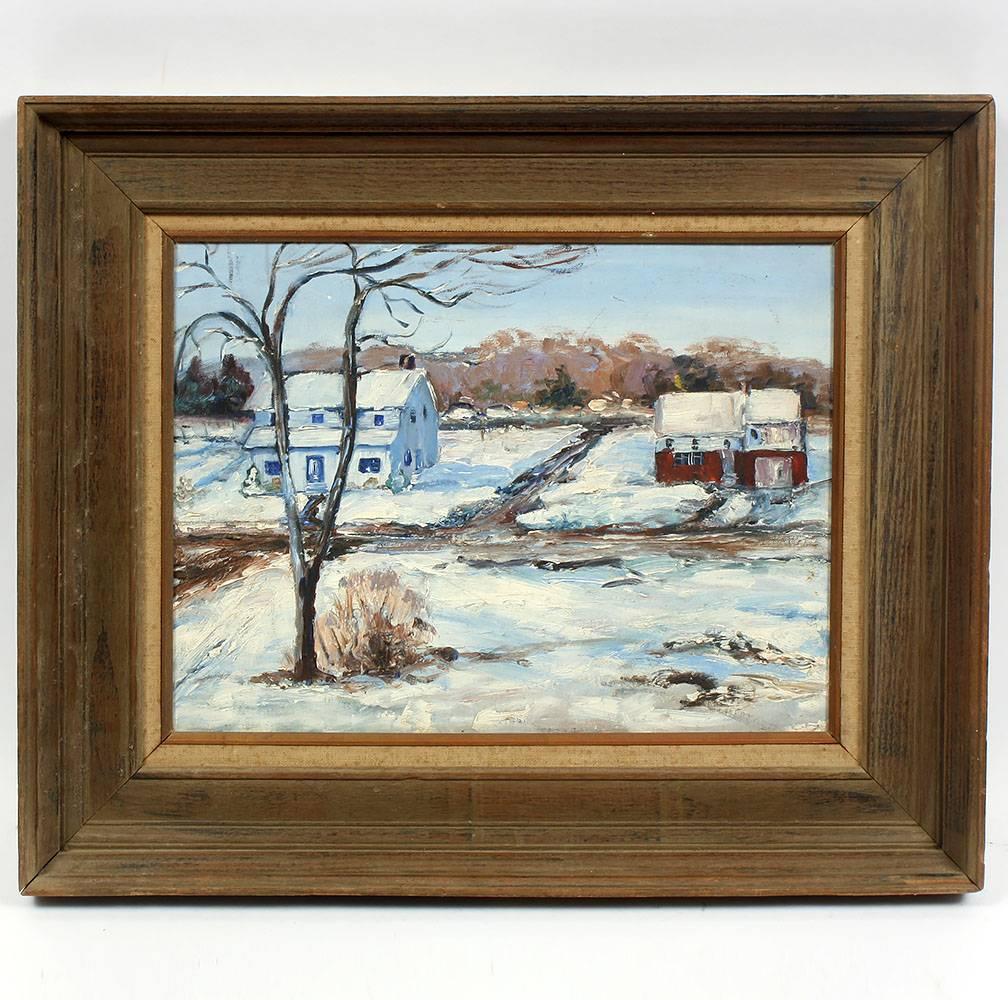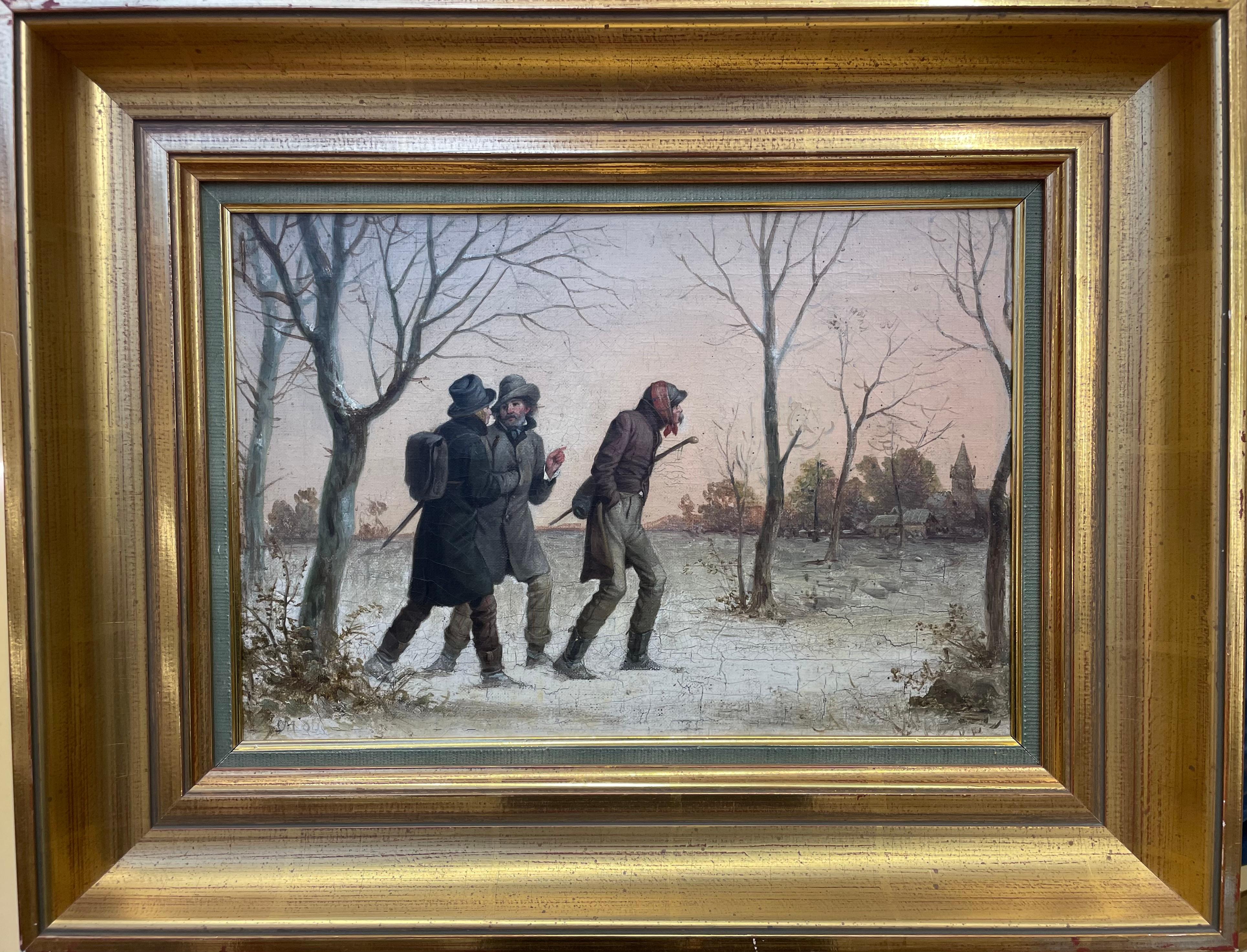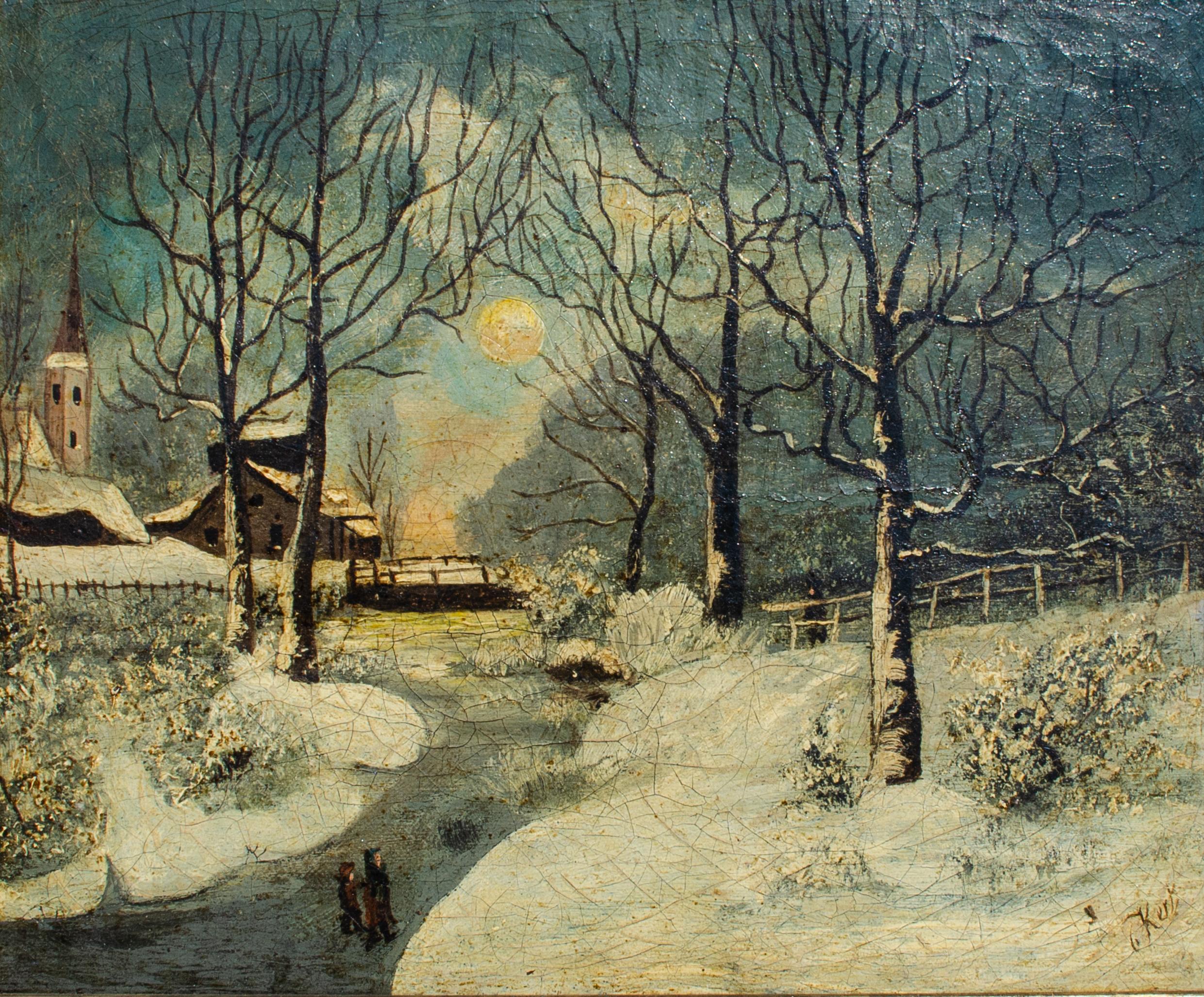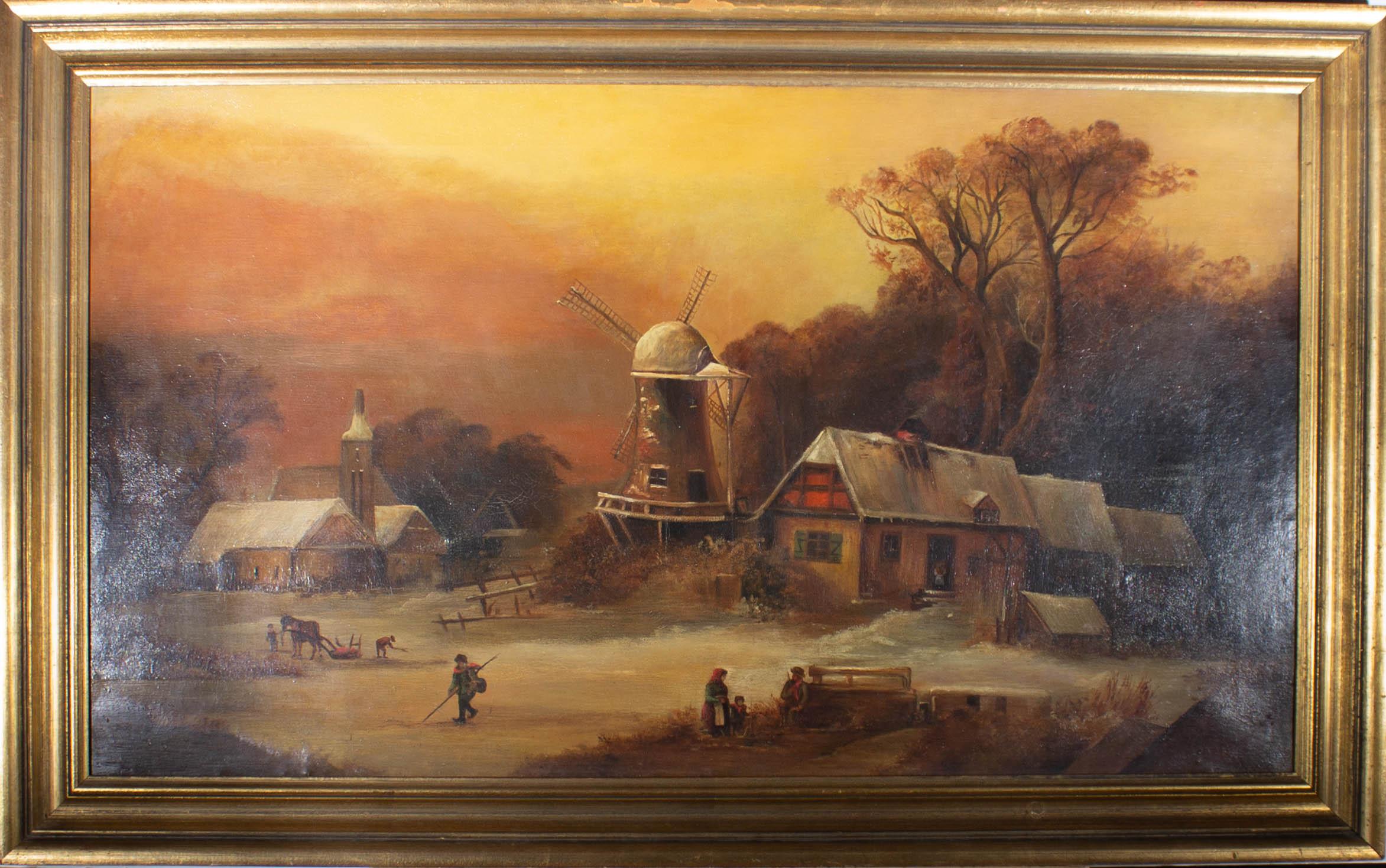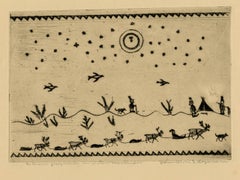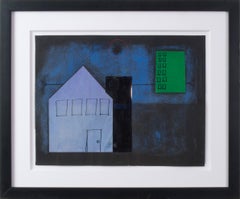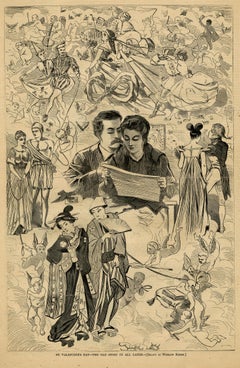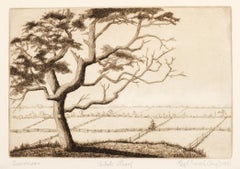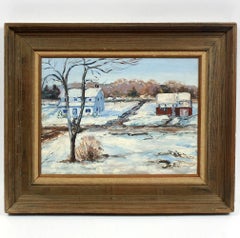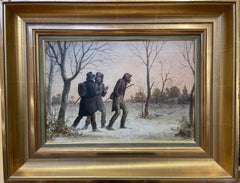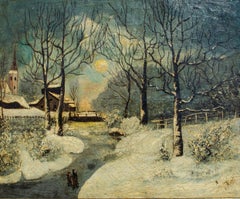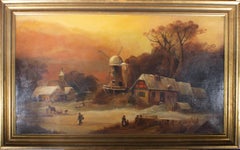Items Similar to Untitled (also known as "1811 THE BACKWOODSMAN'S CHRISTMAS")
Want more images or videos?
Request additional images or videos from the seller
1 of 10
AnonymousUntitled (also known as "1811 THE BACKWOODSMAN'S CHRISTMAS")1875-1925
1875-1925
$1,500
£1,138.79
€1,305.02
CA$2,129.05
A$2,322.26
CHF 1,219.94
MX$28,094.55
NOK 15,261.86
SEK 14,410.23
DKK 9,741.10
About the Item
Untitled (also known as "1811 THE BACKWOODSMAN'S CHRISTMAS")
Oil on canvas, c. 1875-1925
Unsigned
Provenance: Found in Ohio
A charming American naive nocturn of a hunter and his two dogs returning home with his winter food.
Housed in it's original period frame.
A charming American naive nocturn of a hunter and his two dogs returning home with his winter food.
Housed in it's original period frame.
The nocturne and cabin inspired by Currier and Ives?
A commercial reproduction of this image was created and printed in 1903 by McLoughlin Brothers, Inc., a commercial printer specializing in school books. They were printed in electrogravure process and given to schools who bought McLoughlin Brothers school books.
Condition: The painting has been cleaned
Small repair visible in the sky in the upper right quadrant
Appropriate craquelure to the paint surface with stretcher bar line visible
Painting size: 18 x 24 1/2 inches
Frame size: 23 1/2 x 33 1/2 inches
Regarding the print after the painting:
"The Backwoodsman's Christmas copyright 1903 by the McLoughlin Bros. NY
This 107 year old electrogravure (etching on steel by galvanic means ~ then transferred to paper) is a reproduction of the original 1811 Backwoodsman's Christmas by the McLoughlin Brothers. McLoughlin Brothers, Inc. was well-known during the 1828-1920 time period. The company was a pioneer in color printing technologies in children's books and specialized in the retellings of classic stories for children. This picture would at times be seen in old schoolhouses ~ and this may have been due to the fact that the schools purchased books from the McLoughlin Brothers. This was a promotional piece to the schoolhouses."
From Wikipedia
"McLoughlin Bros., Inc. was a New York publishing firm active between 1858 and 1920. The company was a pioneer in color printing technologies in children's books. The company specialized in retellings or bowdlerizations of classic stories for children. The artistic and commercial roots of the McLoughlin firm were first developed by John McLoughlin, Jr. (1827–1905) who made his younger brother Edmund McLoughlin (1833 or 4-1889) a partner in 1855. By 1886, the firm published a wide range of items, including cheap chapbooks, large folio picture books, linen books, puzzles, games, paper soldiers and paper dolls. Many of the earliest and most valuable board games in America were produced by McLoughlin Brothers of New York. In 1920 the corporation was sold to Milton Bradley & Company. McLoughlin ceased game production at this time, but continued publishing their picture books. MB itself was purchased by Hasbro in 1984 and merged with Parker Brothers in 1998 to form Hasbro Games. The two became brands of Hasbro until 2009 when they were retired in favor of the Hasbro name.
In this artwork for Teddy the Bear by Sarah Noble Ives, printer's notes regarding ink colors can be seen in the top left.
The company worked with numerous artists of the time, including Sarah Noble Ives, William Bruton, Edward P. Cogger, Enos Comstock, Frances Bassett Comstock, Georgina A. Davis, Henry Walker Herrick, Justin H. Howard, May Audubon Post, Victor Renwick, Ida Waugh, and Lois Williams. These artists created richly colored watercolors as well as pen-and-ink drawings, which were adapted to the printing processes for mass production.
In 1951 the firm, now a division of Milton Bradley, was sold to Julius Kushner. At that time, their collection of original artwork for publication was split between members of the board. A portion of that collection was later donated to the American Antiquarian Society. In 1954, McLoughlin Brothers books were sold to Grosset & Dunlap"
- Creator:Anonymous (1875 - 1925, American)
- Creation Year:1875-1925
- Dimensions:Height: 18 in (45.72 cm)Width: 24.5 in (62.23 cm)
- Medium:
- Movement & Style:
- Period:
- Condition:
- Gallery Location:Fairlawn, OH
- Reference Number:Seller: FA122071stDibs: LU14015623252
About the Seller
5.0
Recognized Seller
These prestigious sellers are industry leaders and represent the highest echelon for item quality and design.
Platinum Seller
Premium sellers with a 4.7+ rating and 24-hour response times
Established in 1978
1stDibs seller since 2013
815 sales on 1stDibs
Typical response time: <1 hour
Associations
International Fine Print Dealers Association
- ShippingRetrieving quote...Shipping from: Fairlawn, OH
- Return Policy
Authenticity Guarantee
In the unlikely event there’s an issue with an item’s authenticity, contact us within 1 year for a full refund. DetailsMoney-Back Guarantee
If your item is not as described, is damaged in transit, or does not arrive, contact us within 7 days for a full refund. Details24-Hour Cancellation
You have a 24-hour grace period in which to reconsider your purchase, with no questions asked.Vetted Professional Sellers
Our world-class sellers must adhere to strict standards for service and quality, maintaining the integrity of our listings.Price-Match Guarantee
If you find that a seller listed the same item for a lower price elsewhere, we’ll match it.Trusted Global Delivery
Our best-in-class carrier network provides specialized shipping options worldwide, including custom delivery.More From This Seller
View Alluntitled (Returning Home with Supplies)
By Gustav Hagermann
Located in Fairlawn, OH
untitled (Returning Home with Supplies)
Signed in pencil by the artist lower right (see photo)
Signed by his printer, Otto Felsing lower left ((see photo)
Annotated in pencil: "In kupfer geschnitten von einen Lapplander"
Printed by Otto Felsing, one of Germany's master printers of the era
One of several engravings Hagemann made based upon actual drawings given to him by Laplanders.
Gustav Hagemann was born on February 17, 1891, in Engelnstedt, Salzgitter, Germany. Hagemann attended high school in Wolfenbüttel and studied at the art school, in Kassel, Germany. After graduating as an art teacher, he became a trainee teacher in Torgau in Saxony.
He fought in the First World War between 1914-1918. After the war he studied art from 1920...
Category
1930s Outsider Art Landscape Prints
Materials
Drypoint
untitled
By Remo Michael Farruggio
Located in Fairlawn, OH
Pastel, colored pencil with collage elements
Unsigned
Condition: Repaired tear in the area of the moon, only visible from verso
Pin holes in the corners and in the ...
Category
1940s Surrealist Mixed Media
Materials
Pastel, Mixed Media, Color Pencil
St. Valentine's Day -- The Old Story in All Lands
By Winslow Homer
Located in Fairlawn, OH
St. Valentine's Day -- The Old Story in All Lands
Wood engraving, 1868
Published in: Harper's Weekly, February 22, 1868
Titled and signed in the block
Image size: 13 5/8 x 9 inches
C...
Category
1860s Hudson River School Figurative Prints
Materials
Engraving
Survivor
By Ray H. French
Located in Fairlawn, OH
Signed , dated and titled in pencil by the artist
Artist proof from the second printing by Jon Clemens
Annotated "To Jon from Ray"
Category
1980s Abstract Landscape Prints
Materials
Etching
Nashville in Winter
By Louis Oscar Griffith
Located in Fairlawn, OH
Nashville in Winter
Etching, c. 1928
Signed in pencil lower right (see photo)
Very small edition
A rare image of early Nashville, Indiana
Excellent impression with plate tone in the sky
First state before the aquatint depicting a winter nocturne with fall snow
Printed on a fine laid paper with a Crown & Shield watermark
Provenance: Estate of the artist
By decent
Louis Oscar Griffith
(1875-1956)
Born in Greencastle, Indiana, Griffith grew up in Dallas, Texas where Texas artist and teacher Charles Franklin Reaugh recognized young “Griff’s” artistic talent. At age 18, Griffith moved to St. Louis where he attended the St. Louis School of Fine Arts.
In 1895, he moved to Chicago where he worked making color prints for the firm Barnes and Crosby. He attended the Art Institute of Chicago and during a brief stay in New York, the National Academy of Design. A successful commercial artist with a studio in the Chicago Loop...
Category
1920s American Realist Landscape Prints
Materials
Etching
Before the Cock Crow Twice, Thou Shalt Deny Me Thrice
By William C. Grauer
Located in Fairlawn, OH
Signed lower right William C. Grauer
Exhibited at the Cleveland Museum of Art "37th May Show," 1955.
Category
1950s Paintings
Materials
Oil, Board
You May Also Like
American Modernist Snowscene
Located in Buffalo, NY
A modern 1940s American oil painting depicting a rural landscape in winter. This work comes housed in a rustic barn wood frame likely original to the piece
Category
1940s American Modern Landscape Paintings
Materials
Board, Oil
"Winter Wonderland"
Located in Edinburgh, GB
Unidentified Artist (19th Century)
"Winter Wonderland" (1885)
This charming 19th-century oil painting captures a winter landscape, depicting three figures trudging through the snow, engaged in animated conversation. The scene is set against a serene rural backdrop, where bare trees and a distant village silhouette convey the stark beauty of winter. The soft glow of the sky, transitioning from warm hues to cool whites, enhances the tranquil yet brisk atmosphere of a cold winter’s day.
Plot & Interpretation
The three travelers appear to be peasants or laborers, possibly returning home or embarking on a journey.
Their layered winter clothing, fur hats, and backpacks suggest they are seasoned wanderers or workers, braving the elements.
The gesturing figure in the middle seems to be engaged in storytelling or giving directions, adding a sense of movement and interaction.
The snow-covered ground and delicate shadows create depth, emphasizing the hardship and resilience of rural life in the 19th century.
Materials & Condition
Medium: Oil on canvas
Framed Dimensions: 47 x 46 cm
Canvas Dimensions: 24 x 34 cm
Frame: Ornate giltwood frame, enhancing the painting’s classical aesthetic
Condition: Well-preserved with minor age-related patina, in line with its 1885 dating
Historical Context & Artistic Style
Likely influenced by Northern European realism, particularly Russian, German, or Scandinavian schools that depicted harsh winters and rural peasant life.
Comparable to the works of Adolf von Meckel, Vasily Perov, or Carl...
Category
19th Century Romantic Figurative Paintings
Materials
Canvas, Oil
Classic American Winter Landscape Signed G. Kent
Located in New York, NY
G. Kent
Untitled, c. 1880-1910
Oil on canvas
10 x 12 1/4 in.
12 x 14 1/8 x 1 3/8 in.
Signed lower right: G. Kent
Category
Early 20th Century Folk Art Landscape Paintings
Materials
Canvas, Oil
20th Century Oil - Mid Winter
Located in Corsham, GB
A large and charmingly naive Winter landscape in oil showing a small Dutch settlement in the countryside, covered in snow. The painting is unsigned and has been presented in a substa...
Category
21st Century and Contemporary Landscape Paintings
Materials
Oil
$695 Sale Price
20% Off
19th Century European Painting Winter Scene, circa 1870s Unsigned
Located in Incline Village, NV
Excellent quality 19th century European oil painting on canvas (possibly Russian). Winter scene depicting two horse drawn sleighs d...
Category
Antique 19th Century European Paintings
Materials
Canvas
Vintage oil painting on canvas, Winter Landscape, Village, figures. Framed
Located in Palm Coast, FL
This delightful winter landscape painting portrays a quaint rural village scene set along a frozen river or pond, likely in the 19th century. The composition is centered around a gro...
Category
20th Century Impressionist Landscape Paintings
Materials
Oil
$472 Sale Price
20% Off
More Ways To Browse
Antique Christmas
Antique Quadrant
Currier And Ives
Antique Currier And Ives
Antique Teddy Bears
Teddy Bear Antique
Antique Cogs
Antique School Books
Antique Paper Dolls
Howard Post
Soldier Doll
Charles Francois Daubigny
Covered Wagon
Dawson Montague
Eucalyptus Painting
George Williams
Greenwich Paintings
Impressionist Painting Thames
